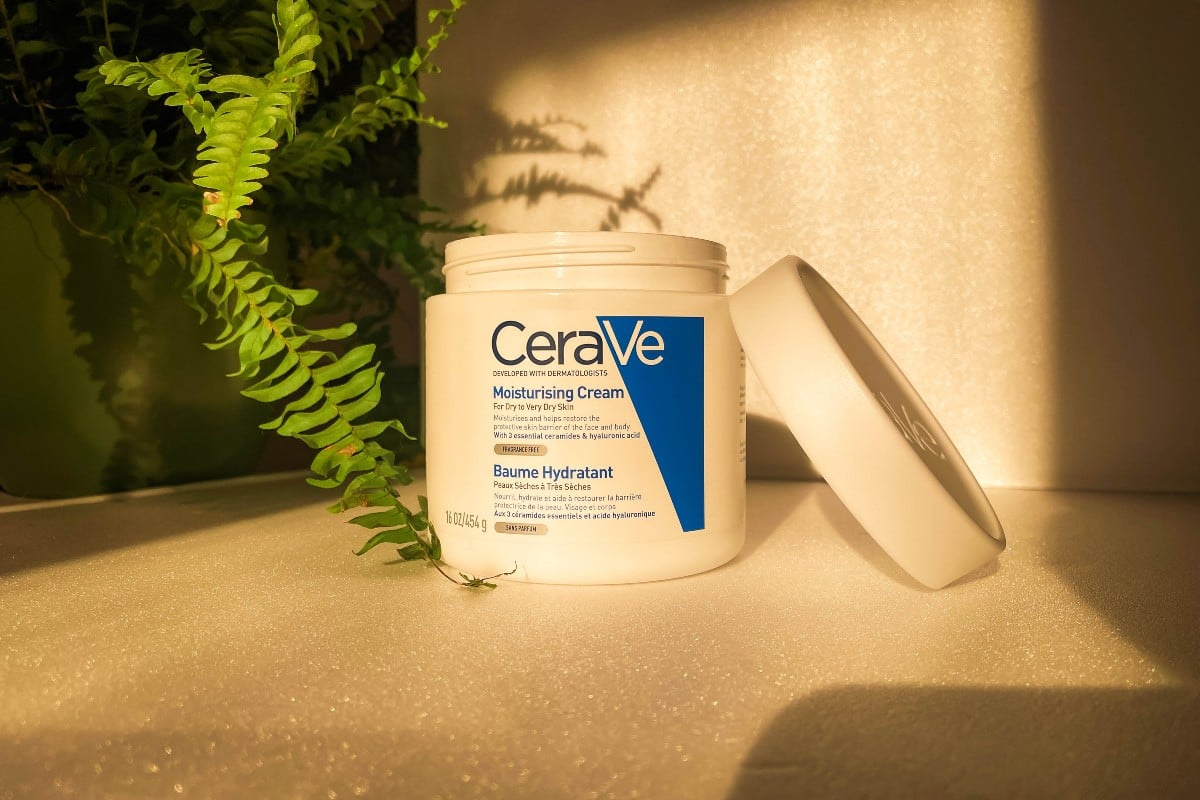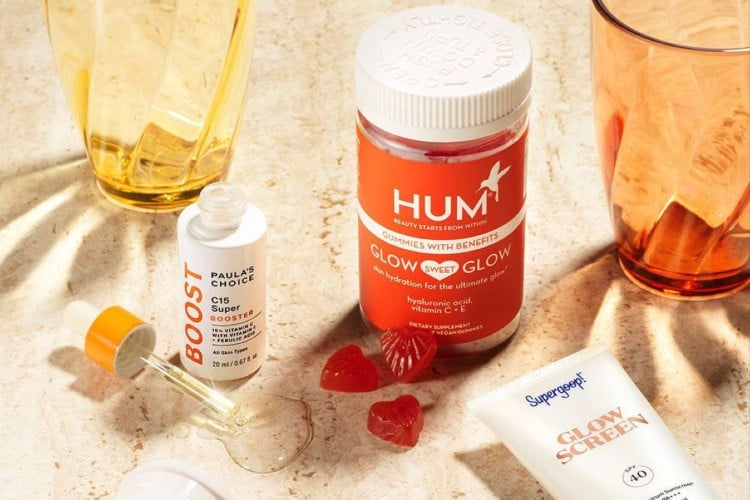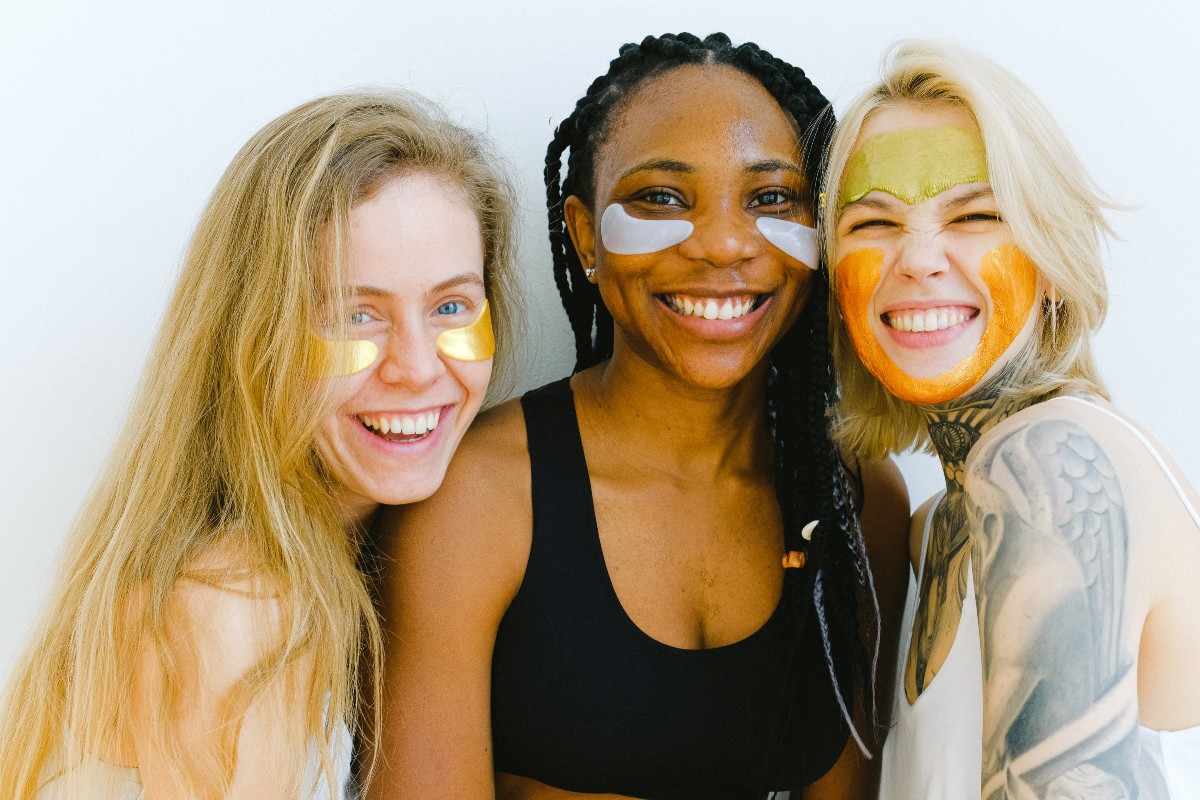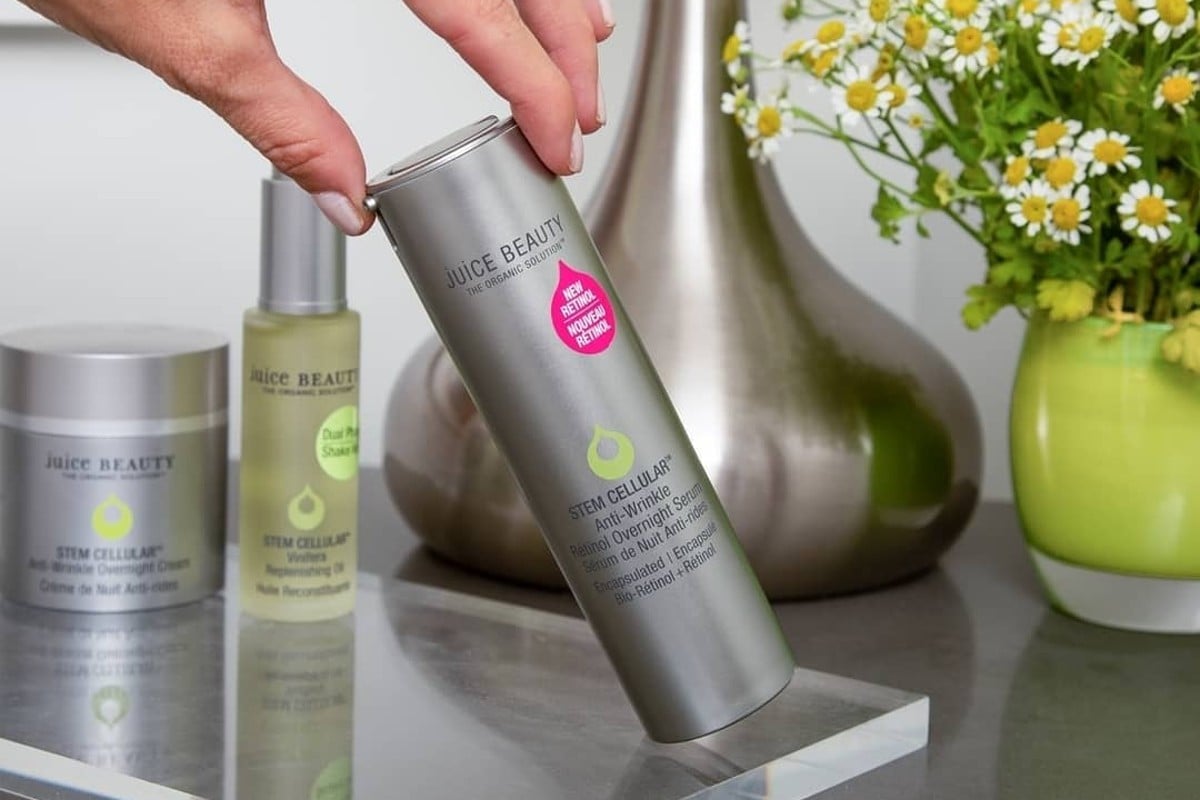OK, here’s the gist: you can’t literally rewind the clock of skin aging, and whether you like it or not, fine lines and wrinkles will sooner or later appear as the years pass by. But that doesn’t mean you shouldn’t fight back and turn on your defense against aging. From adjustment to your skincare routine and lifestyle changes, you can do plenty of things to delay aging signs and make your skin appear 20 years younger. Ready to turn back the clock on the skin aging process? Here’s what you need to do from A to Z to reverse your skin age by as much as 20 years.
What causes skin aging?
Skin ages because of both intrinsic (internal) and extrinsic (external) factors. Aside from the biological process, skin aging is most often accelerated by external foes such as UV exposure, smoking, pollution, and chemicals, to name a few.[1] But of all, exposure to UV rays is the most concerning, being the leading culprit of premature skin aging and thought to be responsible for 80% of facial wrinkles.[2]
What’s important to note is that skin ages differently depending on how much it has been exposed to environmental damage. Intrinsically (aka naturally) aged skin is usually thin, lightly wrinkled, and slightly dry, unlike photoaged skin, which is thicker, rough, hyperpigmented, and shows deeper and more prominent wrinkles.[3]
What happens to our skin as we age?
Aging causes a series of changes in the skin. To reverse the process (or slow it down), you must address each cause at its roots. The aim is to replenish what skin loses with age, strengthen its defense against external damage, and cut out the culprits that weaken it.
Here’s what happens to the skin as it ages:
Decreased collagen and elastin
On the whole, skin tends to become thin, wrinkled, dull, and saggy as we get older because of the reduced functionality of the extracellular matrix, which is a large network of proteins and molecules that surround and support the entire skin’s structure.[1][2]
Collagen, elastin, and hyaluronic acid are all components of the extracellular matrix that have the role of maintaining skin elasticity, firmness, and hydration, and their levels slowly decline with age. FYI, your body starts to lose about 1% of the total collagen every year. Over time, this causes the skin to lose its strength and integrity, leading to sagging, dehydration, wrinkles, and roughness.
Reduced cell turnover
Another effect of skin aging is a decrease in cell turnover, which is basically the skin’s ability to renew itself by replacing old cells with fresher, healthier ones.[1] As a result of slow cell turnover, the skin becomes dull, with a rough and uneven texture, and more susceptible to breakouts.
Less sebum
Skin also becomes drier and less resilient due to decreased production of sebum, an oily substance made by the body’s sebaceous glands that coat the skin’s surface to maintain it moisturized and protected. It turns out that sebum production decreased by as much as 60% in aged people, leaving skin more susceptible to water loss and environmental damage.[1]
One way to deal with sebum loss is to use squalane, a substance that mimics sebum and does wonders at coating the skin’s surface with a protective layer to hinder water evaporation.
Decreased lipids impair the skin barrier
The stratum corneum, also referred to as the epidermal barrier (outermost skin layer), is a key player in protecting the skin against environmental aggressors. It also has the role of controlling transepidermal water loss—the stronger the barrier, the less moisture skin loses.[4]
This protective barrier is mainly made of lipids, precisely ceramides, cholesterol, and fatty acids, whose levels considerably decrease as we get older. It turns out that the lipid content of aged skin is reduced by as much as 65%, leading to a weakened barrier that’s more susceptible to water loss and external damage.[2] Over time, these changes can lead to dehydration, reduce skin tolerance, and, even worse, could trigger atopic dermatitis and exacerbate aging signs.
NAD synthesis is reduced
NAD+, or nicotinamide adenine dinucleotide, is a coenzyme found in every cell in our body which is involved in hundreds of cellular processes, including turning nutrients into energy, repairing DNA, and increasing cell proliferation. These processes are incredibly important for the skin to stay firm and resilient. Researchers who have been studying this molecule for years add weight to the idea that NAD+ may play a role in biological aging and longevity and not simply as an electron carrier.[5]
But as with anything else, as the body ages, it produces less NAD+ due to a deficiency of vitamin B3 (which is required to synthesize NAD+), resulting in UV sensitivities and damaged DNA. This further accelerates the skin aging process. For this reason, it’s essential to maintain optimal levels of NAD+ so every cell can fulfill its roles and slow down senescence.
Luckily, the decrease of NAD levels can be easily prevented with vitamin B3 and its derivatives, niacinamide, nicotinamide mononucleotide (NMN), and nicotinamide riboside (NR).
Fewer amino acids
With age, the levels of amino acids also start to decline. These are molecules that combine to form proteins and peptides and are the building blocks of collagen and elastin. They also form the natural moisturizing factor, a complex of substances that have the role of helping skin retain moisture and providing protection against chemicals, allergens, and microbes.
Studies found that the loss of amino acids caused by aging has a major influence on the skin’s capacity to bind water and protect itself against external foes.[6] That said, a deficiency in amino acids can lead to skin that’s more prone to developing early aging signs.
How to reverse the skin aging process
Turning back the clock on skin aging is all about reversing the changes caused by the aging process. Here’s what you need to do to preserve your skin firmness and elasticity as you get older:
- Increase NAD+ levels with vitamin B3
- Replenish collagen, elastin, and hyaluronic acid
- Apply retinoids to increase cell turnover
- Fortify the skin’s barrier with ceramides, cholesterol, and fatty acids
- Use antioxidants to stay defended against oxidative stress
- Exfoliate or perform a chemical peel
- Resort to skin tightening treatments
- Use sunscreen daily
- Eat selectively
- Exercise at least four hours a week
- Take control of the stress level and practice mindfulness
- Sleep well
- Have a targeted skincare routine
Increase NAD+ levels with vitamin B3
Vitamin B3 is the building block of NAD+, which is an enzyme responsible for hundreds of cellular functions that deplete with aging. So replenishing NAD+ levels with vitamin B3 should be your top priority to turn on your defenses against skin aging. Aside from pure vitamin B3, niacinamide (another form of vitamin B3), nicotinamide mononucleotide (NMN), and nicotinamide riboside (NR) have been found to considerably boost NAD+ levels in the body.[5] To increase NAD+, you can:
- Eat foods rich in vitamin B5 and its derivatives, including cow’s milk, vegetables (broccoli), fruits (avocado), and meat.
- Take supplements with NAD precursors, including niacinamide, nicotinic acid, nicotinamide mononucleotide, and nicotinamide riboside. A recent study from 2021 specifically found that oral supplementation of 500mg niacinamide led to a significant increase in NAD+ after 12h.[7]
- Practice regular physical exercise.
- Use topical products containing vitamin B3. The most common forms of vitamin B3 found in skincare formulations include niacinamide and myristyl nicotinate (known as NIA-114 from StriVectin). For instance, a study found that a cream containing NIA-114 increased NAD levels by 25%.[8] Another study reported a major improvement in fine lines and wrinkles, dark spots, and skin elasticity after applying a 5% niacinamide cream for 12 weeks.[9]
Replenish collagen and hyaluronic acid
Restoring collagen, elastin, and hyaluronic acid levels has been proven countless times to minimize the impact of aging on the skin’s appearance.[1][2][3] Everything starts with having a diligent skincare routine, considering supplements, and reducing sun exposure.
That said, taking supplements with collagen and hyaluronic acid for 12 weeks is a good start to slow down the skin aging process. Supplements with vitamin C also help a lot as they’re known to stimulate collagen production in addition to reducing oxidative damage.
Topical products are useful as well. Ideally, your treatment serum should contain skin-restoring ingredients such as retinol, vitamin C, hyaluronic acid, peptides, and niacinamide—all build collagen, strengthen the skin and enhance moisture and firmness. You would want to check out Matrixyl and epidermal growth factors, which are some of the best-in-class peptides that send signals to cells to repair and build proteins.
And don’t forget your sunscreen. Sun exposure damages the cells and accelerates the aging process, so protect your skin all day long.
Apply retinoids to increase cell turnover
Retinoids like retinol, retinal, and tretinoin are all forms of vitamin A that can considerably speed up cellular turnover and stimulate collagen production—two processes that slow down with aging. Their topical application is, in fact, known and endlessly times proven to improve all forms of aging signs, including fine lines, wrinkles, dark spots, sagginess, and lack of moisture.[10] For this reason, a retinoid product, like these retinol serums, is a must to win the battle against skin aging.
Strengthen the skin’s barrier
The epidermal barrier gets weaker and weaker with age, causing dehydration and increased sensitivities. The good news is that using a cream containing ceramides, cholesterol, and fatty acids—lipids that form the barrier—can recover and strengthen it so it can fulfill its role in reducing water loss and external damage.[11] Having a robust barrier is necessary to prevent premature aging signs, and that’s why you need products like SkinCeuticals Triple Lipid Restore 2:4:2 and Paula’s Choice Ceramide-Enriched Firming Moisturizer.
Use antioxidants
Sun exposure, pollution, and smoking all speed up the aging process and have one thing in common: they generate free radicals. Free radicals are unstable molecules that can enter the skin, where they can trigger cell damage and lead to oxidative stress, which is known as the main culprit that causes premature skin aging. This is where antioxidants come to the rescue — they counteract oxidation by disarming free radicals. You can boost your body’s antioxidant content by eating foods rich in antioxidants or using targeted skincare products.
Resort to skin tightening treatments
Skin tightening treatments are probably the holy grail of anti-aging regimens. They work by using targeted energy to heat the deeper layers of the skin where the collagen-producing cells are. This is how collagen and elastin are instantly stimulated, gradually improving skin texture, elasticity, and firmness. For instance, radiofrequency, the most common treatment used in skin tightening devices, heats the dermis to 50-75°C, eliminating wrinkles and firming the skin in the long run.
Protect your skin against sunlight
The sun can dramatically accelerate the aging process, altering the normal skin structure and degrading collagen levels. Sun exposure can also negatively affect retinoic acid receptors and retinoid X receptors and lead to a deficiency of vitamin A, which can result in cell damage. Considering that about 80% of facial wrinkles are attributed to sun exposure, there’s really no need to think twice — having your skin protected against UV daily is non-negotiable. To shield your skin against sun damage, use sunscreen with UVA and UVB protection with at least 30 SPF. We like these the most.
Eat selectively
No doubt, what you eat influences how your skin ages. As you get older, you should consider moderating your total food intake. Cut out anything processed and avoid high glycemic-index foods like carbohydrates, unhealthy fats, sugar, and dairy, as they can affect your blood pressure.
On the flip side, the nutrition of someone who wants to control the aging signs needs to be rich in antioxidants such as carotenoids and flavonoids, vitamins (A, C, D, and E), essential omega-3-fatty acids, proteins, and probiotics.[12] They help protect the skin from oxidative damage, reduce cell inflammation, and reduce collagen degradation.
These are the healthiest foods for the skin:
- Broccoli: rich in vitamins C and K
- Spinach: contains vitamins A, C, and E
- Nuts: good source of nutrients, vitamins, and healthy fats
- Kiwi: bags tons of vitamins C and E
- Bell peppers: rich in vitamin C
- Sushi, fish in general: is chock full of omega fatty acids
- Chocolate: full of flavanols
- Avocados: contain vitamin B3
Exercise daily
It’s believed that exercise reduces sagginess through the collagen increase and also from muscle toning and pulling the skin tight. Also, exercise boosts blood flow in the body, facilitating nutrient delivery while eliminating toxins through sweat. The Journal of the American Academy of Dermatology suggests that regular exercise (more than 4 hours per week of high-intensity exercise) can decrease the aging of skin cells as well as mitigate the impact of free radicals.[13] If you are not really a sports person, you can just walk 30 minutes every day. That counts too.
Take control of the stress level
The stress can harm critical DNA in the cells. The length of DNA sections is called telomeres. People exposed to stress often have the shortest telomeres — when telomeres become too short, the cells can die or become damaged, which causes the skin to age prematurely.[14] So, breathe deep, listen to your favorite music, dance, meditate, read a book, or do anything else that helps you relieve tension.
What else
- Have a targeted skincare routine: To reverse your skin age, your skincare routine should revolve around replenishing collagen, elastin, and hyaluronic acid levels. For that, retinoids, hyaluronic acid, niacinamide, peptides, vitamin C, ceramides, amino acids, and fatty acids are the MVPs. We recommend switching between a vitamin C serum and a niacinamide one in the morning and the retinol serum with a peptide formula at night.
- Sleep well: Sleep is the golden chain that ties health and our bodies together, and you need it to keep your skin in good shape. On the opposite, not sleeping enough can accelerate the aging process. A 2015 even study found that poor sleep quality often leads to an upsurge in aging signs and a weakened barrier.[15] During the research, they observed that good sleepers had 30% better skin recovery than poor sleepers, while poor sleepers had a dramatic increase in water loss.
- Exfoliate your skin regularly: Use chemical acids once or twice weekly to exfoliate your skin. Exfoliation removes dead cells from the top layer of the skin, which comes with a long list of benefits, including smoothing texture, reducing fine lines, and brightening skin. These glycolic acid peels are perfect for that.
- Take supplements: Take supplements daily packed with vitamins A, B5, C, and E, coenzyme Q10, and omega fatty acids.
- Resort to cosmetic procedures as the last measure: Injection with hyaluronic acid, laser resurfacing, and microneedling have all been proven effective in diminishing aging signs. But you shouldn’t rely on them unless your skincare routine and lifestyle changes haven’t yielded the results you expected.
- Quit smoking
Sources
Women’s Concepts uses reliable sources, including dermatologists’ insights, clinical trials, and scientific journals, to find accurate information and support all the facts shared in our articles. All statements and claims have clear and legit references. Read our editorial policy to learn more about our sources of information, our process of researching and fact-checking the content, and how our team strives to keep all articles updated, completed, and trustworthy.
- Farage MA, Miller KW, Elsner P, Maibach HI. Characteristics of the Aging Skin. Adv Wound Care (New Rochelle). 2013 Feb.
- Zhang S, Duan E. Fighting against Skin Aging: The Way from Bench to Bedside. Cell Transplant. 2018 May.
- Ganceviciene R, Liakou AI, Theodoridis A, Makrantonaki E, Zouboulis CC. Skin anti-aging strategies. Dermatoendocrinol. 2012.
- Van Smeden J, Bouwstra JA. Stratum Corneum Lipids: Their Role for the Skin Barrier Function. Curr Probl Dermatol. 2016.
- Massudi H, Grant R, Braidy N, Guest J, Farnsworth B, Guillemin GJ. Age-associated changes in oxidative stress and NAD+ metabolism in human tissue. PLoS One. 2012.
- Clare-Ann Canfield, Patrick C. Bradshaw. Amino acids in the regulation of aging and aging-related diseases. 2019
- Takashi K. Ito, Tomohito Sato, A single oral supplementation of nicotinamide within the daily tolerable upper level increases blood NAD+ levels in healthy subjects. 2021
- Jacobson EL, Kim H, Kim M, Williams JD, Coyle DL, Coyle WR, Grove G, Rizer RL, Stratton MS, Jacobson MK. A topical lipophilic niacin derivative increases NAD, epidermal differentiation and barrier function in photodamaged skin. Exp Dermatol. 2007 Jun.
- Bissett DL, Oblong JE, Berge CA. Niacinamide: A B vitamin that improves aging facial skin appearance. Dermatol Surg. 2005 Jul;31(7 Pt 2):860-5; discussion 865.
- Mukherjee S, Date A, Patravale V, Korting HC, Roeder A, Weindl G. Retinoids in the treatment of skin aging: an overview of clinical efficacy and safety. Clin Interv Aging. 2006.
- Jungersted, J.M., Hellgren, L.I., Jemec, G.B.E. and Agner, T. (2008), Lipids and skin barrier function – a clinical perspective. Contact Dermatitis, 58: 255-262. https://doi.org/10.1111/j.1600-0536.2008.01320.x
- Cao C, Xiao Z, Wu Y, Ge C. Diet and Skin Aging-From the Perspective of Food Nutrition. Nutrients. 2020 Mar 24.
- Journal of the American Academy of Dermatology. Exercise in dermatology: Exercise’s influence on skin aging, skin cancer, psoriasis, venous ulcers, and androgenetic alopecia.
- Shammas MA. Telomeres, lifestyle, cancer, and aging. Curr Opin Clin Nutr Metab Care. 2011 Jan.
- Oyetakin-White P, Suggs A, Koo B, Matsui MS, Yarosh D, Cooper KD, Baron ED. Does poor sleep quality affect skin aging?. 2015 Jan.






